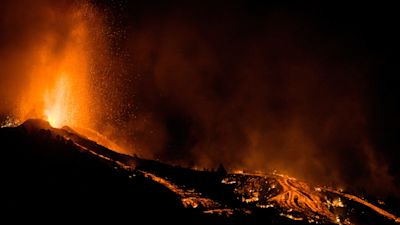Residents flee and lava destroys houses after volcano erupts on Spanish Canary Island

Footage of the volcanic eruption in La Palma filmed by a local resident
A volcano has erupted on the Spanish Canary Island of La Palma, prompting authorities to speed up evacuations for more than 1,000 people as lava flows destroyed isolated houses and threatened to reach the coast.
A huge plume of smoke rose up after the eruption at 3.15 pm local time in the Cumbre Vieja national park, the Canary Islands government said.
Massive red plumes topped with black-and-white smoke shot out along the volcanic ridge, which scientists had been closely watching following the accumulation of molten lava below the surface and days of small earthquakes.
Authorities immediately evacuated over 1,000 people, but Spain’s Civil Guard said it may need to evacuate up to 10,000 residents.
La Palma, with a population of 85,000, is one of eight volcanic islands in Spain’s Canary Islands archipelago off Africa’s western coast.
At their nearest point, the islands are 60 miles from Morocco.
A 4.2-magnitude quake was recorded before the volcanic eruption, which took place in an area known as Cabeza de Vaca on the western slope as the ridge descends to the coast.
As the eruptions continued, at least two open mouths launched bright red magma into the air that then flowed in tight streams down the mountain slope.
Shortly after the initial explosion hit the area, one black lava flow with a burning tip immediately slid toward houses in the village of El Paso.
Mayor Sergio Rodríguez said 300 people in immediate danger were evacuated, roads were closed and authorities urged the curious not to approach the area. The lava eventually reached some homes, causing at least one chalet with a tower to crumble. Authorities warned that the lava flows could also threaten the municipalities of El Paraíso, Alcalá and surrounding areas.
The Scientific Committee of the Volcano Risk Prevention Plan said stronger earthquakes “are likely to be felt and may cause damage to buildings”.
The committee of experts also noted that a stretch of the island’s southwest coast was at risk for landslides and rock falls.
The Canary Islands Volcanology Institute reported the eruption, which last erupted in 1971.